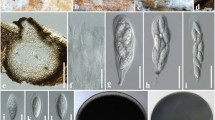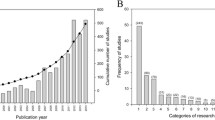Abstract
Although Africa harbors low species diversity compared to the neotropics or South East Asia, the African fern flora is of interest because of its specific composition and geographic location between the neotropics and Asia. We address the question of how the evolution of the African fern flora may have been enriched by repeated input from the neotropics and Asia. For the purpose of this paper we consider ihree major biogeographic regions: the neotropics, Africa and Madagascar, and Asia including Malesia and Australasia. We interpret distribution data for six clades of Polypodiaceae in a molecular phylogenetic framework. We conclude that African fern taxa shared with or closely related to ones in the neotropics or Asia have been brought about by ancient and recent dispersal events with or without subsequent speciation. The African fern flora is interpreted as being composed of endemic, neotropical, and Asian elements and as being situated in a zone of overlap of typical neotropical and Asian fern floras.
Similar content being viewed by others
Literature Cited
Aldasoro, J. J., F. Cabezas &C. Aedo. 2004. Diversity and distribution of ferns in sub-Saharan Africa, Madagascar and some islands of the South Atlantic. Journal of Biogeography 31: 1579–1604.
Badré, F. &T. Cadet. 1978. The pteridophytes of Réunion Island. Fern Gazette 11: 349–365.
Barrington, D. S.. 1993. Ecological and historicals factors in fern biogeography. Journal of Biogeography 20: 275–280.
Brownsey, P. J.. 2001. New Zealand's pteridophyte flora —plants of ancient lineage but recent arrival? Brittonia 53: 284–303.
Burrows, J. E. 1990. Southern African Ferns and Fern Allies. Frandsen Publishers, Sandton.
Christensen, C. 1912. On the ferns of the Seychelles and the Aldabra group. Transactions of the Linnean Society of London. Ser. 2, Botany. 7: 409–425.
Conant, D. S. 1983. A revision of the genusAlsophila (Cyatheaceae) in the Americas. Journal of the Arnold Arboretum 64: 333–382.
Collinson, M. E. 2001. Cainozoic ferns and their distribution. Brittonia 53: 173–235.
Dassler, C. L. &D. R. Farrar.. 2001. Significance of gametophyte form in long-distance colonization by tropical, epiphytic ferns. Brittonia 53: 352–369.
Davis, C. C., C. D. Bell, P. W. Fritsch &S. Mathews. 2002. Phylogeny ofAcridocarpus-Brachylophon (Malpighiaceae): implications for tertiary tropical floras and afroasian biogeography. Evolution 56: 2395–2405.
—,P. W. Fritsch, C. D. Bell &S. Mathews. 2004. High-Latitude Tertiary migrations of an exclusively tropical clade: evidence from Malpighiaceae. International Journal of Plant Sciences 165: S107-S121.
Donoghue, M. J. &B. R. Moore. 2003. Toward an integrative historical biogeography. Integrative and Comparative Biology 43: 261–270.
Felsenstein, J. 1985. Confidence limits on phylogenies: an approach using the bootstrap. Evolution 39: 783–791.
Hennipman, E. &M. C. Roos.. 1982. A monograph of the fern genusPlatycerium (Polypodiaceae). Verhandelingen der Koninklijke Nederlandsche Akademie van Wetenschappen. Afdeeling Natuurkunde, Sectie 2. 80: 1–126.
Holttum, R. E. 1981. The tree ferns of Africa. Kew Bulletin 36: 463–482.
Hovenkamp, P. 1986. A monograph of the fern genusPyrrosia, Polypodiaceae. Leiden Botanical Series 9: 1–280.
Janssen, T. &H. Schneider. 2005. Exploring the evolution of humus collecting leaves in drynarioid ferns (Polypodiaceae, Polypodiidae) based on phylogenetic evidence. Plant Systematics and Evolution 252: 175–197.
Johns, R. J. 1991. Pteridophytes of tropical East Africa —a preliminary checklist of the species. Royal Botanical Gardens, Kew.
Kato, M. 1993. Biogeography of ferns—dispersal and vicariance. Journal of Biogeography 20: 265–274.
Kreier, H.-P. &H. Schneider. 2006a. Phylogeny and biogeography of the staghorn fern genusPlatycerium (Polypodiaceae, Polypodiidae). American Journal of Botany 93: 217–225.
——. 2006b. Reinstatement ofLoxogramme dictyopteris, based on phylogenetic evidence, for the New Zealand endemics fernAnarthropteris lanceolata (Polypodiaceae, Polypodiidae). Australian Systematic Botany 19: 309–314.
Kubitzki, K., editor. 1990. The families and genera of vascular plants. Vol. I: Pteridophytes and Gymnosperms. K.U. Kramer & P. S. Green (vol. eds.). Springer-Verlag, Berlin.
Lorence, D. H. 1978. The pteridophytes of Mauritius (Indian Ocean): ecology and distribution. Botanical Journal of the Linnean Society 76: 207–247.
Maddison, D. R. &W. P. Maddison. 2000. MacClade 4.05: Analysis of phylogeny and character evolution. Sinauer Associates, Sunderland, Massachusetts.
McLoughlin, S. 2001. The breakup history of Gondwana and its impact on pre-Cenozoic floristic provincialism. Australian Journal of Botany 49: 271–300.
Moran, R. C. &A. R. Smith. 2001. Phytogeographic relationships between neotropical and African-Madagascan pteridophytes. Brittonia 53: 304–351.
Muñoz, J., Á. M. Felicímo, F. Cabezas, A. R. Burgaz &I. Martínez. 2004. Wind as a long-distance dispersal vehicle in the southern hemisphere. Science 304: 1144–1147.
Nooteboom, H. P. 1997. The microsoroid ferns (Polypodiaceae). Blumea 42: 261–395.
Parris, B. S. 2001. Circum-Antarctic continental distribution patterns in pteridophyte species. Brittonia 53: 270–283.
Plana, V., A. Gascoigne, L. L. Forrest, D. Harris &R. T. Pennington. 2004. Pleistocene and prepleistoceneBegonia speciation in Africa. Molecular Phylogenetics and Evolution 31: 449–461.
Posada, D. &K. A. Crandall. 1998. MODELTEST: testing the model of DNA substitution. Bioinformatics 14: 817–818.
Rakotondrainibe, F. 2003. Checklist of the pteridophytes of Madagascar. Pp. 295–313.In: S. M. Goodman & J. P. Benstead (eds.), Natural history of Madagascar. The University of Chicago Press, Chicago.
Ranker, T. A., A. R. Smith, B. S. Parris, J. M. O. Geiger, C. H. Haufler, S. C. K. Straub &H. Schneider. 2004. Phylogeny and evolution of grammitid ferns (Grammitidaceae): a case of rampant morphological homoplasy. Taxon 53: 415–428.
Renner, S. S. 2004. Multiple Miocene Melastomataceae dispersal between Madagascar, Africa and India. Philosophical Transactions of the Royal Society of London, Series B—Biological Sciences 359: 1485–1494.
—,G. Causing &K. Meyer. 2001. Historical biogeography of Melastomataceae: The roles of tertiary migration and long-distance dispersal. American Journal of Botany 88: 1290–1300.
Ridder-Numan, J. W. A. 1996. The historical biogeography of the Southeast Asian genusSpatholobus (Leguminosae, Papilionoideae) and its allies. Blumea Supplement 10: 1–144.
Ronquist, F. 1997. Dispersal-vicariance analysis: a new approach to the quantification of historical biogeography. Systematic Biology 46: 195–203.
Roos, M. C. 1985. Phylogenetic systematics of the Drynarioideae (Polypodiaceae). Verhandelingen der Koninklijke Nederlandsche Akademie van Wetenschappen. Afdeeling Natuurkunde, Sectie 2. 85: 1–317.
Roux, J. P. 2001. Conspectus of Southern African pteridophyta. SABONET. Pretoria.
Sanmartín, I., H. Enghoff &F. Ronquist. 2001. Patterns of animal dispersal, vicariance and diversification in the Holarctic. Biological Journal of the Linnean Society 73: 345–390.
Sanmartín, I. &F. Ronquist. 2004. Southern hemisphere biogeography inferred by event-based models: plant versus animal patterns. Systematic Biology 53: 216–243.
Schneider, H., T. Janssen, P. Hovenkamp, A. R. Smith, R. B. Cranfill, C. H. Haufler &T. A. Ranker. 2004a. Phylogenetic relationships of the enigmatic Malesian fernThylacopteris (Polypodiaceae, Polypodiidae). International Journal of Plant Sciences 165: 1077–1087.
—,E. Schuettpelz, K. M. Pryer, R. B. Cranfill, S. Magallon &R. Lupia. 2004b. Ferns diversified in the shadow of angiosperms. Nature 428: 553–557.
—,A. R. Smith, R. B. Cranfill, T. J. Hildebrand, C. H. Haufler &T. A. Ranker. 2004c. Untraveling the phylogeny of polygrammoid ferns (Polypodiaceae & Grammitidaceae): exploring aspects of the diversification of epiphytic plants. Molecular Phylogenetics and Evolution 31: 1041–1063.
—,H.-P. Kreier, L. R. Perrie &P. J. Brownsey. 2006a. The relationships ofMicrosorum (Polypodiaceae) species occurring in New Zealand. New Zealand Journal of Botany 44: 121–127.
——,R. Wilson &A. R. Smith. 2006b. TheSynammia enigma: evidence for a temperate lineage of polgrammoid ferns (Polypodiaceae, Polypodiidae) in Southern South Africa. Systematic Botany 31: 31–41.
Smith, A. R. 1972. Comparison of fern and flowering plant distributions with some evolutionary interpretations for ferns. Biotropica 4: 4–9.
—,K. M. Pryer, E. Schuettpelz, P. Korall, H. Schneider &P. G. Wolf. 2006. A classification for extant ferns. Taxon 55: 705–731.
Soltis, P. S. &D. E. Soltis. 1990. Evolution of inbreeding and outcrossing in ferns and fern-allies. Plant Species Biology 5: 1–11.
Sparks, J. S. 2004. Molecular phylogeny and biogeography of the Malagasy and South Asian cichlids (Teleostei: Perciformes: Chichlidae). Molecular Phylogenetics and Evolution 30: 599–614.
— &W. L. Smith. 2004. Phylogeny and biogeography of the Malagasy and Australasian rainbowfishes (Teleostei: Melanotaenioidei): Gondwanan vicariance and evolution in freshwater. Molecular Phylogenetics and Evolution 33: 719–734.
Swofford, D. L. 2000. PAUP*: phylogenetic analyses using parsimony (* and other methods), version 4b10. Sinauer Associates. Sunderland. Massachusetts.
Sytsma, K. J., A. Litt, M. L. Zjhra, J. C. Pires, M. Nepokroeff, E. Conti, J. Walker &P. G. Wilson. 2004. Clades, clocks, and continents: historical and biogeographical analysis of Myrtaceae, Vochysiaceae, and relatives in the southern hemisphere. International Journal of Plant Sciences 165: S85-S105.
Tardieu-Blot, M.-L. 1964a. Ptéridophytes.In: A. Aubréville (ed.), Flore du Cameroun. Muséum national d'Histoire naturelle, Paris.
Tardieu-Blot, M.-L. 1964b. Ptéridophytes.In: A. Aubréville (ed.) Flore du Gabon. Muséum national d'Histoire naturellé. Paris.
Tiffney, B. H. &S. R. Manchester. 2001. The use of geological and paleontological evidence in evaluating plant phylogeographic hypotheses in the northern hemisphere Tertiary. International Journal of Plant Sciences 162: S3-S17.
Tryon, R. M. 1986. The biogeography of species with special reference to ferns. Botanical Review 52: 117–155.
van Uffelen, G. A. 1991. Fossil Polypodiaceae and their spores. Blumea 36: 253–272.
van Zanten, B. O. &S. R. Gradstein. 1988. Experimental dispersal geography of neotropical liverworts. Beiheft zur Nova Hedwigia 90: 41–94.
Verdcourt, B. 2001. Polypodiaceae.In: H. J. Beentje (ed.), Flora of Tropical East Africa. Balkema, Rotterdam.
Vikulin, S. V. &A. E. Bobrov. 1987. A new fossil genusProtodrynaria (Polypodiaceae) from the paleogene flora of Tim (the south of the middle Russian upland). [in Russian]. Botanicheskii Zhurnal 72: 95–98.
Wells, N. A. 2003. Some hypotheses on the Mesozoic and Cenozoic palaeoenvironmental history of Madagascar. Pp. 16–34.In: S. M. Goodman and J. P. Benstead (eds.), Natural history of Madagascar. The University of Chicago Press, Chicago.
Weijermars, R. 1989. Global tectonics since the breakup of Pangea 180 million years ago: Evolution maps and lithospheric budget. Earth-Science Reviews 26: 113–162.
Willis, K. J. &J. C. McElwain. 2002. The evolution of plants. Oxford University Press, Oxford.
Wolf, P. G., H. Schneider &T. A. Ranker. 2001. Geographic distributions of homosporous ferns: does dispersal obscure evidence of vicariance? Journal of Biogeography 28: 263–270.
Wolfe, J. A. 1975. Some aspects of plant geography of the northern hemisphere during the late Cretaceous and Tertiary. Annals of the Missouri Botanical Garden 62: 264–279.
Yuan, Y.-M., S. Wohlhauser, M. Möller, J. Klackenberg, M. W. Callmander &P. Küpfer. 2005. Phylogeny and biogeography ofExacum (Gentianaceae): a disjunctive distribution in the Indian Ocean Basin resulted from long distance dispersal and extensive radiation. Systematic Biology 54: 21–34.
Zhang, L.-B. &S. S. Renner. 2003. The deepest splits in Chloranthaceae as resolved by chloroplast sequences. International Journal of Plant Sciences 164: S383-S392.
Zink, M. J. 1993. Systematics of the fern genusLepisorus (J. Smith) Ching (Polypodiaceae-Lepisoreae). Inaugural-Dissertation, Universität Zürich. ADAG Administration und Druck AG, Zürich.
Author information
Authors and Affiliations
Corresponding author
Rights and permissions
About this article
Cite this article
Janssen, T., Kreier, HP. & Schneider, H. Origin and diversification of African ferns with special emphasis on Polypodiaceae. Brittonia 59, 159–181 (2007). https://doi.org/10.1663/0007-196X(2007)59[159:OADOAF]2.0.CO;2
Issue Date:
DOI: https://doi.org/10.1663/0007-196X(2007)59[159:OADOAF]2.0.CO;2




